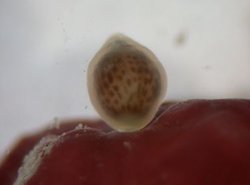Larva (Biodiversity)
Contents
Larva
Definition
A larva is a distinct juvenile life stage associated with certain faunal species, most notably with certain butterfly, moth and a gamut of other arthropod, chordate, annelid, mollusk and echinoderm species. A larva typically has a morphology that is very different from its adult stage, both in overt appearance and in organ functionality; in fact, the larval habitat itself can be totally disjunct from that of the adult. The larval life stage is also frequently found to a wide number of faunal parasites. Charles Darwin was one of the first to note the role of larval adaptation in the process of speciation. [1] The normal plural form of the term is based upon its Latin origin: hence, larvae.
Taxonomic scope
Larvae are distinctly occuring life stages chiefly found in certain species within the phylla Arthropoda, Chordata, Mollusca, Echinodermata, Annelida and Cnidaria. Among Arthopods a notable order of occurrence is decapoda within the Crustacea sub-phyllum, which order includes many prominent shrimp, lobster and crayfish species. Another large taxonomic group within Arthropoda is the class insecta, including several prominent orders with larval stages, such as Coleoptera (beetles), Diptera (mosquitos and other true flies), Hymenoptera (bees/wasps), Lepidtoptera (butterflies/moths), Hemiptera (aphids and other true bugs) and Ephemeroptera (mayflies).
Within the phyllum Chordata there are numerous species of fish, amphibians, eels and lampreys that exhibit larval life stages. Among Mollusca there are a number of bivalves such as mussels that manifest larval stages. Among Annelida there are numerous segmented worms with larval life stages, many of which are notable faunal parasites. Among phyllum Cnidaria taxa, a chief class of occurrence are hydrozoa, a taxon of principally saltwater dwelling predators that includes many species of jellies.
Role in life stages
The larval form of a species typically has a functionality that is very different from the adult stage. It has adapted to seek food and habitat that are often radically different from that of an adult. In the case of parasites, the larval stage often is associated with an incubation stage within a faunal host.
In the case of all Lepidoptera species the larval life stage is the second of four in each organism's life cycle: it is preceded by the egg stage and succeeded by the pupa and adult stages. [2] In the larval stage, certain species may have well defined differential morphology, with these sub-stages often called instars.
In certain cases the organism may not progress beyond the larval form, e.g.for some newt species, this circumstance of arrested larval development is termed neotony.
Early scientific note
While Darwin may have been the first scientist to observe in detail many of the environmental and behavioral features of larvae, earlier note was made by Lord Monboddo (who also preceded Darwin in articulating the basic concept of evolution of species),[3][4] Sir J. Lubbock and others as to the significance of this early life stage in many species. In particular, Darwin noted the role which certain larvae play in the process of adaptation and speciation, and particularly observed that the role of this early life stage is as important in the evolutionary process as that of more mature life stages .By the early 1900s numerousorganisms were classified as to their larval descriptions, including considerable differentiation of instars.[5]
References
^ Charles Darwin. 1859. The Origin of Species. reprinted by Doubleday Books, Garden City, New Jersey, USA
^ Thomas C. Emmel, Marc C. Minno and Boyce A. Drummond. 1992. Florissant butterflies: a guide to the fossil and present-day species. 118 pages
^ Appletons journal of literature. science and art. 1870. vol. 3, page 110
^ James Burnett, Lord Monboddo. 1779-1799. Antient Metaphysics, six volumes
^ Royal Entomological Society of London. 1916. Transactions of the Royal Entomological Society of London.


